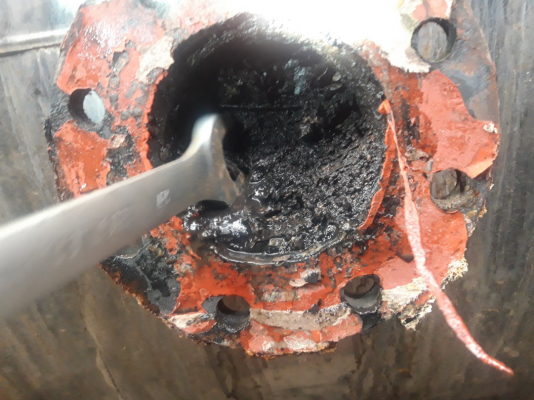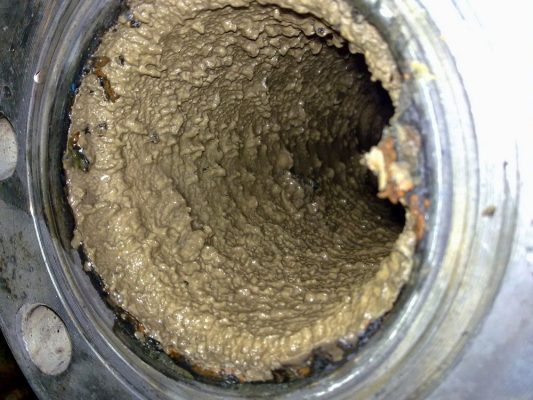However, there are some misconceptions about boiler feedwater:
Some people believe that water in a boiler just needs good heat transfer properties, much like oil in different types of heaters or gas in cooling devices. They think that boiler feedwater doesn’t necessarily need to be clean.

On the contrary, others argue that boiler feedwater must be entirely pure and free from impurities.
Boiler feedwater needs not only to meet basic quality criteria but also to have low hardness to prevent scaling and corrosion within the system. This is crucial for maintaining thermal efficiency and preventing negative impacts on the system.
When water is boiled, the chemicals in it can change. This process can create insoluble scale, which complicates heat transfer and water transport in the equipment. These scales have various physical and chemical properties, from color to hardness and adhesion to metal surfaces.
Risks of neglecting water treatment in boilers
When scale and other special substances accumulate in the heat exchange tubes, the heat exchange efficiency diminishes, leading to fuel wastage and vibrations in the pipelines. White scale, typically composed of calcium and magnesium compounds like CaCO3 and MgCO3, may appear as sludge or crystals and adhere to the surface of the boiler tubes.
In reality, boiler tubes often have a reddish-brown color, not white. This is due to the corrosive effects of salts and acids in the water, along with the presence of oxygen and high temperatures, which cause the iron in the boiler tubes to react and form brown scale.

Phenomena like vibrations and jolts in the boiler tubes are usually due to the presence of gases like oxygen and CO in the water. These gases not only corrode the boiler tubes but can also create other problems such as water hammer, scratching, and swelling of the boiler tubes.
Purpose of water treatment in boilers
Proper treatment of boiler feedwater can extend the lifespan of the boiler, protect the tubes, and reduce thermal energy consumption.
Preserving Boiler Lifespan
According to Vietnamese standard TCVN 7704 – 2007, the expected lifespan of a boiler is between 15-20 years, provided it meets all standard requirements. To achieve this, water treatment needs to:
- Prevent scaling: Bottom-blowing the boiler 2-3 times a day can help maintain a scale layer not exceeding 1 mm in thickness.
- Prevent corrosion: The water drained from the boiler’s bottom should not be reddish-brown.
- Use efficient degassing units: This is important for boilers with capacities of 5 tons of steam per hour or higher.
Fuel Saving
When boiler tubes are less scaled, heat exchange efficiency increases, thereby reducing fuel consumption.
Approaches to boiler water treatment
Boiler water treatment can be accomplished through several different methods, such as:
Softening Water and Removing Acidic Ions:
- Mechanical Method: Using sedimentation tanks and filters to remove acidic ions from water. However, this method has limitations as it cannot remove impurities smaller than 1 mm in diameter. Therefore, it is ineffective and rarely used in boilers.
- Chemical Method: Using various chemicals to remove water hardness, usually effective only with salts that are carbonate-based. This method is costly and less frequently used due to its low effectiveness.
- Cation Exchange Method: This involves the reaction between positive ions (cations) in water with cation exchange resins, creating new substances that do not cause scaling. This is commonly used in boiler operations with various types of cation resins like NaR, HR, and NH4R.
- Using Sodium Cation Resin (NaR): This type completely removes hardness without altering the water’s anionic components and alkalinity.
- Using Hydrogen Cation Resin (HR): Additional NaR is required to prevent the formation of acid that can corrode the boiler tubes.
By considering these approaches, one can optimize the boiler operation, thereby enhancing efficiency and prolonging the equipment’s lifespan.
Water treatment methods for boilers
SOFTENING WATER AND REDUCING ACID SALTS:
Mechanical method
This method uses settling tanks and filters to separate acid salts from water. However, its limitation is that it cannot filter impurities smaller than 1mm in diameter. The efficiency is very low, and the filtered water is not suitable for boilers.
Chemical method
Chemicals are used, typically removing hardness by precipitating salts containing Carbonate. This method cannot treat hardness without Carbonate salts. Hence, while it is costly, its efficiency is not high and is infrequently used.
Cation exchange method
This creates a reaction process that exchanges the cations of dissolved hard substances in water, resulting in a chemical reaction between the substances causing scale and cationic resin particles.
New substances that do not cause scale are created. Cationic resins are synthetic treatment substances with a base R that holds cations and are insoluble in water. Scale-forming cations are retained, while other cations enter the boiler system through the feedwater. This method is widely used in boilers.
Entities using boilers often use different types of cationic resins to treat boiler water: sodium cationic resin (NaR), hydrogen cationic resin (HR), and ammonium cationic resin (NH,R).
Using Sodium Cationic Resin will remove all hardness without changing the alkalinity and other anion components.
The chemical reactions are as follows:
2NaR+ Ca (HCO3)2 -> CaR2 + 2NaHCO3.
2NaR+ Mg (HCO3)2 -> MgR2 + 2NaHCO3.
2NaR+ CaCl2 -> CaR2+2NaCl.
2NaR+ MgCl2 -> MgR2 + 2NaCl.
2NaR+ CaSO4 -> CaR2 + Na2SO4.
2NaR+ MgSO4 -> CaR2 + Na2SO4.
Using Hydrogen Cationic Resin to treat water hardness will result in the H* base forming an acid that corrodes boiler tubes. Therefore, when treating water with HR, NaR must also be used.
Using NH R results in a very small remaining hardness, but it produces NH3 nd acid that corrodes metal, so similarly, when using NH4R NaR is also added. After a certain period, the cationic resins lose their cations. To make the resins function as they did initially, a swap with substances that can regenerate the original cationic resin is needed. This process is called the cationic resin regeneration process.
The regeneration process is as follows: To regenerate sodium cationic resin, a 28% NaCl solution is used. Chemical equations:
CaR2+2NaCl -> CaCl2 + NaR
MgR2+2NaCl -> MgCl2 + NaR
This regeneration process lasts approximately 60 minutes, consisting of the following phases:
- Backwash: This removes insoluble sediments from the top. The process must be slow to prevent resin from being carried away.
- Clean salt wash for about 30 minutes
- Rinsing salt with soft water
- Ending the washing process and testing for hardness.
pH INCREASE
The pH is adjusted using water treatment chemicals, commonly based on Na. The boiler water pH must be maintained appropriately to prevent corrosion. This creates a buffering system containing both NaOH and phosphate salts.
Types of gases to be treated and methods
In feedwater for boilers, the main gases to be treated are oxygen and, to a lesser extent, carbon dioxide. Other gases are typically negligible. To remove these gases, there are two main methods:
Increasing Feedwater Temperature
For gases that do not react with water, and are at low concentration and pressure, their solubility in water depends on pressure and temperature. This method uses steam from the boiler to boil the feedwater. When feedwater evaporates at atmospheric pressure, the gases are removed due to their partial pressure dropping to zero.
However, when feedwater evaporates and is pumped into the boiler, cavitation can occur in the pump, leading to rapid damage. Therefore, in practice, the temperature is usually only raised to 90-95°C, accepting that some gas remains in the water.
Chemical Addition
Reducing agents, commonly referred to as “oxygen scavengers,” are used to treat the remaining dissolved oxygen in water. The commonly used chemicals include Sodium sulfite, hydrazine hydrate, and carbohydrazide.
Boiler water treatment process
The boiler water treatment process typically undergoes 3 stages:
Cation exchange
- Purpose: To reduce water hardness (Add 6-8% NaCl to the source water to remove CaCl, MgCl2).
- Application: Used only for source water (Not for condensate water).
- Result: Typically reaches just 2-3 mg/l, whereas the total hardness requirement is < 2 mg CaCO3/l.
Deaeration tank
- Purpose: To remove dissolved O2 in water.
- Application: For both source and condensate water.
- Result: Nearly achieved (result ≥ 0.5 mg/l), while dissolved oxygen requirement is < 0.1 mg/l.
Chemical addition
- Purpose: To treat the remaining parts so that the water meets the standard, including hardness and gas removal.
- Application: For both source and condensate water.
Results: All indicators in the Standard must be achieved. They are met when:
- Immediate check: Bottom blowdown water is not red.
- Periodic check: Boiler tubes have no scale, are not pitted, and are not scratched.

 Tiếng Việt
Tiếng Việt




